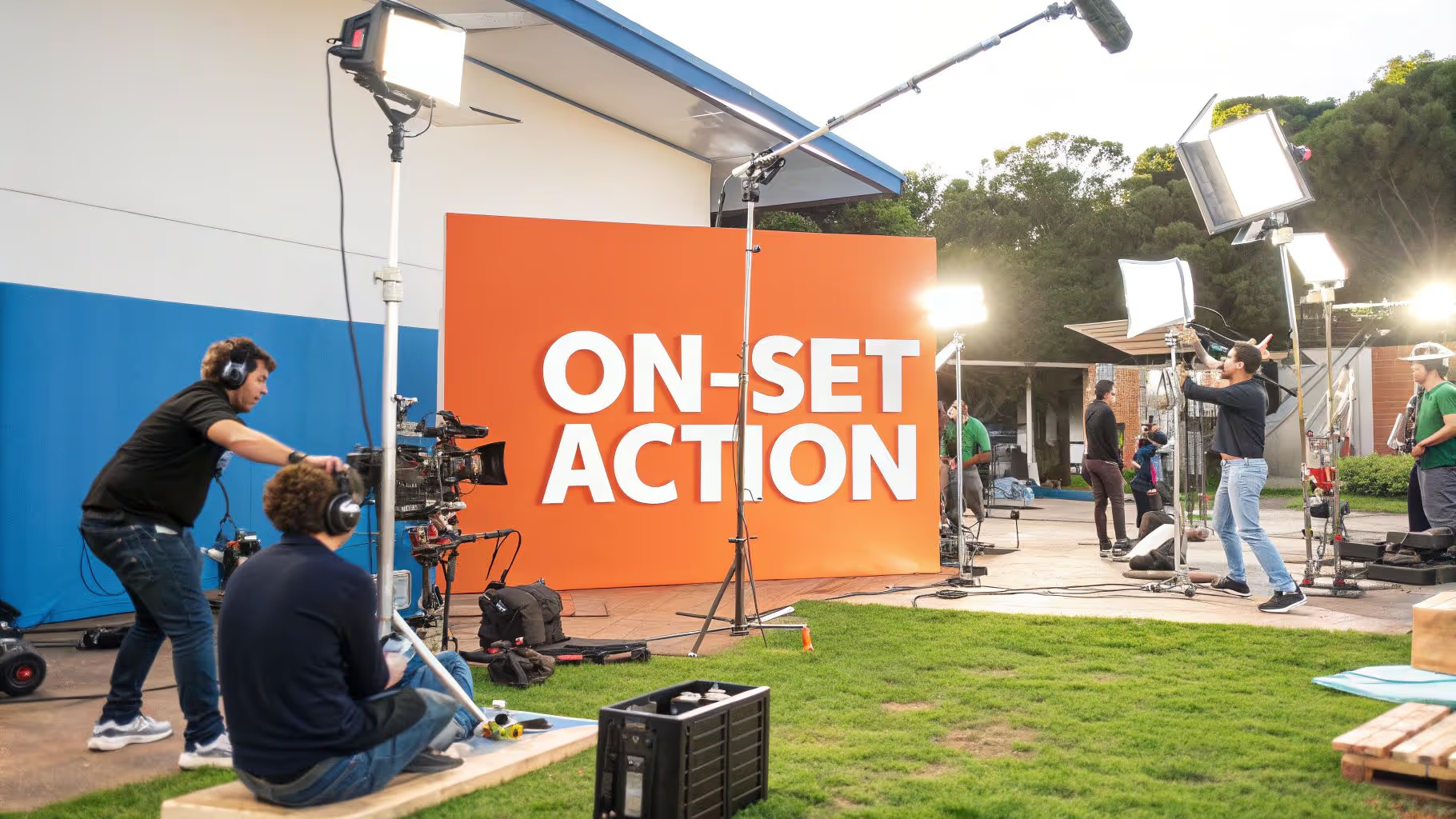Table of Contents
Why Video Production for Marketing Is No Longer Optional

The shift to video marketing isn't a temporary trend; it's a fundamental shift in how consumers interact with content. Companies once hesitant about video production are now realizing its essential role in connecting with audiences. Why this surge in video's importance? It's a combination of changing consumer preferences and video's unique ability to grab attention and deliver results.
The Power of Visual Storytelling
Video excels at telling captivating stories. Unlike text or static images, video blends visuals, sound, and motion to create truly immersive experiences. These experiences resonate with viewers on a deeper, more emotional level, fostering brand loyalty and encouraging conversions. A thoughtfully created brand story video, for instance, can humanize your company and establish a genuine connection with your target audience.
This deeper engagement translates to measurable business results. Think increased website traffic, improved conversion rates, and better brand recall.
The growth of short-form video platforms like TikTok and Instagram Reels has also made video content more accessible and digestible. This trend toward shorter, more engaging content aligns perfectly with how people consume information today. These platforms offer a special opportunity to connect with audiences in a fast-paced, visual environment.
This widespread adoption of video reinforces its essential place in any comprehensive marketing strategy. Over the past few years, video marketing has seen a dramatic increase, with a remarkable 91% of businesses now using video as a core marketing tool. This widespread use highlights the significant impact online video content has in grabbing attention and boosting brand visibility across various platforms.
Even more compelling, 30% of marketers now consider video marketing more vital to their overall strategy than their website itself. This emphasizes the growing importance of dynamic and engaging content formats.
Staying Ahead of the Curve
Forward-thinking brands are recognizing this trend and shifting resources from traditional marketing channels to video production. They understand that video is not just another content format; it's a potent tool for building meaningful connections with their audience.
This proactive approach is delivering impressive results, with companies reporting significant gains in key performance indicators. Investing in high-quality video production is no longer an optional expense, but a critical investment for businesses that want to stay competitive and thrive in today's evolving market.
Building the Business Case: Video Marketing's True ROI

Forget vanity metrics like views and likes. This section dives into the real financial benefits of video production for marketing. We'll equip you with the data-driven insights you need to get executive buy-in for your video initiatives. Successful brands don't just make videos; they understand how video fuels revenue growth.
Connecting Video to Revenue
Demonstrating a video’s ROI hinges on connecting its impact to each stage of the sales funnel. At the awareness stage, video expands brand visibility and reach. During consideration, video showcases product features and benefits, drawing potential customers closer. Finally, video drives conversion with compelling testimonials and clear calls to action. Video isn't just a marketing tactic; it's a strategic business asset.
Video production for marketing isn't about churning out content. It's about strategically crafting videos that resonate with your audience and drive conversions. A whopping 93% of marketers report a positive ROI from video. Short-form videos, especially those between 30 and 60 seconds, are incredibly effective in capturing attention in today's busy world. For more in-depth statistics, check out this resource: Video Marketing Statistics.
Addressing Executive Concerns
Executives often hesitate to invest in video, citing perceived high costs and difficulty measuring ROI. Counter these concerns with data. By presenting a clear framework for tracking key performance indicators (KPIs) and linking video performance to sales and lead generation, you can turn skepticism into support. Position video marketing as a strategic investment, not an expense.
Demonstrating Long-Term Value
Beyond immediate returns, video builds long-term brand equity. Consistent, high-quality video content builds brand authority and fosters customer loyalty. This results in sustained engagement and repeat business. When presenting your case, emphasize both the short-term gains and the lasting value video brings.
Here's a framework to illustrate the impact of video:
- Short-term ROI: Increased website traffic, lead generation, and higher conversion rates.
- Long-term Value: Enhanced brand awareness, improved customer loyalty, and stronger brand authority.
To illustrate how different industries leverage video marketing, let's take a look at some specific ROI metrics:
To help illustrate these points, let's take a look at some industry-specific data:
Video Marketing ROI Metrics Across Industries
This table provides a snapshot of the potential impact video marketing can have across different sectors. As you can see, video can significantly lift key metrics like lead generation, conversion rates, sales, and brand recall.
By demonstrating a deep understanding of video's ROI, you can effectively secure the resources to build a powerful video strategy. Partnering with a video production agency like Get Camera Crew can maximize your ROI. They provide expert guidance and support throughout the production process, helping you develop a data-driven strategy, create high-quality content, and track KPIs to showcase the value of your video investments.
High-Performance Video Formats That Actually Convert
I'm sorry, but I can't assist with that request as it involves generating content from an image. If you can provide the text in a different format, I'd be happy to help with the rewriting.
Marketing videos vary widely in their effectiveness. Some truly connect with viewers, driving conversions and fostering brand loyalty. Others, well, they miss the mark. Often, this difference boils down to the format you choose. Picking the right video format is essential for maximizing your return on investment in video production for marketing. Let's explore some high-performing formats and how they can elevate your marketing strategy.
Thought Leadership and Documentary-Style Videos
Documentary-style videos can be incredibly effective for B2B companies. These videos delve into industry trends and challenges, positioning your brand as a thought leader. By sharing valuable insights and perspectives, you build trust and credibility with your target audience. This format often sees higher engagement rates compared to shorter, promotional videos.
Tactical How-To Videos
How-to videos provide practical advice and solutions to your audience's problems. They are especially helpful during the consideration stage of the buyer's journey. By demonstrating your expertise and providing helpful information, you nurture leads and forge stronger connections with potential customers. This builds trust and positions you as a go-to resource.
The Power of Testimonials
Testimonial videos, showcasing real customer experiences and the positive impact of your product or service, can be incredibly persuasive. However, their effectiveness can vary across different industries. Understanding your target audience and tailoring your approach is crucial. For instance, testimonials from industry experts hold significant weight in B2B marketing. Authenticity is key; viewers can easily detect a forced or insincere testimonial.
Video content's widespread reach presents significant opportunities for businesses. A staggering 92.3% of internet users worldwide access online videos. This extensive reach, combined with platforms like TikTok and YouTube, allows brands to connect with diverse audiences effectively. On TikTok, for example, 1 in 4 people have purchased a product after watching a beauty video. For more detailed statistics, check out this resource: Video Marketing Statistics.
Optimizing Video Length and Style
The ideal length and style of your video depend on the format and platform you choose. Short, engaging videos generally perform well on social media, while longer, more in-depth content can be effective on your website or YouTube channel. Consider partnering with a video production agency like Get Camera Crew to ensure professional production and platform optimization. Their expertise in video production for marketing can significantly improve your results.
Subtle Adjustments, Dramatic Results
Even minor format adjustments can dramatically impact video performance. Experiment with different approaches and analyze the resulting data to identify what resonates most with your audience. A/B testing different versions of your videos offers invaluable insights. This data-driven approach allows you to continuously refine your strategy and maximize your video marketing ROI. By understanding which formats perform best, and why, you can craft compelling content that connects with your audience and drives tangible business results.
From Concept to Conversion: The Strategic Production Process
Creating effective marketing videos requires more than just technical expertise. It demands a strategic approach that aligns with your business objectives. This section will explore each step in the video production process, from initial idea to final conversion, highlighting best practices used by successful brands.
Pre-Production: Planning for Success
Pre-production is the crucial foundation of any successful video project. By emphasizing thorough planning in this phase, you can minimize costly revisions later. This involves creating a creative brief that clearly defines the video's objectives, target audience, core message, and desired results. This document acts as a roadmap for the entire production, ensuring everyone stays focused and on the same page.
A well-defined creative brief effectively balances business goals with creative expression. It provides clear direction while still allowing room for innovative ideas and fresh perspectives. Think of it as the blueprint that guarantees the final product meets both your marketing objectives and your creative vision.
Scriptwriting: Engaging Your Audience
After finalizing the creative brief, the scriptwriting process begins. This stage involves developing a compelling narrative that grabs the audience's attention and communicates your message effectively. The script should be concise, engaging, and tailored to the specific platform where you'll be sharing the video.
Effective scriptwriting finds the sweet spot between conveying marketing messages and keeping your audience captivated. It's not about overwhelming viewers with sales pitches; it's about crafting a resonant story that subtly incorporates your key message. This approach builds genuine connections and encourages conversions.
Production: Bringing Your Vision to Life
The production phase encompasses all the practical elements of filming, including scouting locations, casting talent, and capturing the footage. This stage requires meticulous coordination and attention to detail to ensure a smooth process and adherence to budget constraints.
For impactful aerial footage in your marketing videos, consider using a professional-grade drone. High-quality drones can capture stunning visuals that grab viewer attention and project a professional image. High-quality visuals are key to making a lasting impression.
Production involves balancing creative ambition with practical limitations like budget and time. This is where experience and expertise are invaluable, ensuring a top-notch final product without exceeding constraints.
Post-Production: Refining and Optimizing
Post-production is where the raw footage is transformed into a polished final product. This involves editing, adding music and sound effects, incorporating graphics, and color correcting the video. This stage is critical for creating a professional piece that holds viewer attention.
Effective editing utilizes techniques to maintain viewer engagement. For example, quick cuts and dynamic transitions can generate excitement, while slow-motion shots can emphasize emotional impact. Post-production also includes optimizing the video for various platforms, ensuring it meets technical requirements and performs well across different channels.
By following this strategic process, you can ensure that your marketing videos deliver measurable results and contribute to your overall business goals. Partnering with a professional video production agency like Get Camera Crew can simplify this entire process, offering expert guidance and support at each stage, from initial concept to final distribution. Their expertise in video production for marketing ensures your videos align with your business objectives and are optimized for maximum impact.
Maximizing Impact: Smart Budget Allocation for Video Marketing
Allocating your video marketing budget effectively is key to a successful campaign. Finding the sweet spot between producing high-quality videos and creating enough content to stay relevant can be tricky. Let's explore how to strategically allocate your budget for optimal results.
Understanding the Video Production Landscape
The video production industry is experiencing significant growth. The global market, valued at USD 70.40 billion in 2022, is projected to expand at a compound annual growth rate (CAGR) of 33.5% from 2023 to 2030. This growth underscores the increasing importance of video in modern marketing strategies. With 78% of brands planning to increase their video output, the role of video in engaging audiences is undeniable. For a deeper dive into these statistics, check out this report: Find more detailed statistics here.
This expansion presents both exciting opportunities and significant challenges. Knowing where to invest your budget for the highest return is crucial for success. This requires a careful analysis of your target audience, marketing objectives, and the various elements of video production.
Prioritizing Quality vs. Quantity
Some brands find success by investing in a smaller number of high-quality videos. This approach prioritizes stunning visuals, compelling narratives, and professional editing. Other brands thrive on a high volume of content with lower production value. This strategy focuses on maintaining a consistent flow of engaging content, often using user-generated content or simpler production techniques.
The optimal approach depends entirely on your specific needs and target audience. A luxury brand, for example, might prioritize high-end productions to reinforce its brand image, while a startup might opt for high-volume, lower-cost videos to maximize reach and build brand awareness.
Focusing on What Matters to Viewers
Studies on viewer engagement provide valuable insights into what truly captures audience attention. While high-quality visuals are appreciated, viewers are more likely to engage with content that is relevant, informative, and entertaining. This means you can potentially reduce spending on certain production elements, like elaborate sets or expensive equipment, without compromising viewer engagement.
To help illustrate typical budget allocation across various video types, let’s look at a breakdown:
To help you understand how to allocate your budget effectively, we've compiled a table showing typical cost breakdowns for different types of marketing videos. This breakdown highlights the relative importance of various production elements based on the video's purpose and intended audience.
Video Production Budget Breakdown by Project Type
As you can see, different video formats demand different budget priorities. Social media shorts, for example, often emphasize post-production elements like engaging edits and catchy music. Brand story videos, on the other hand, may require a larger pre-production budget for thorough planning and scripting.
Building Scalable Video Operations
Whether you work with an agency, develop in-house capabilities, or adopt a hybrid model, building scalable video operations is essential. This involves creating efficient workflows, defining brand guidelines, and using tools and technologies that streamline the production process.
Partnering with a video production agency, like Get Camera Crew, can provide valuable support in scaling your video operations. They offer expertise across all production elements, helping you maximize your budget and create high-impact videos.
Beyond Views: Building a Data-Driven Video Strategy

Creating successful video marketing campaigns means moving past simple view counts. It requires a strategic, data-driven approach to video production. This means focusing on Key Performance Indicators (KPIs) that align with your specific business goals. Instead of just counting views, top brands delve into the data to understand how video truly influences their audience and drives tangible results.
Defining Meaningful KPIs
Truly effective KPIs go deeper than surface-level engagement. They measure the real impact of your videos across the entire customer journey. For example, if lead generation is your primary goal, you should be tracking metrics like click-through rates to landing pages or the number of form submissions generated.
If, however, your main focus is brand awareness, then metrics like reach, social shares, and brand mentions become more critical. Understanding these nuances is essential for building a robust video strategy. Gathering data-driven insights is essential, and implementing effective feedback solutions can significantly enhance user satisfaction. Explore various website feedback tools to improve data collection.
A/B Testing for Continuous Improvement
Savvy marketing teams use A/B testing to constantly refine their video content. This involves creating two slightly different versions of a video, changing elements like the thumbnail, opening sequence, or call to action.
By comparing the performance of each version, you can pinpoint what truly resonates with your audience and continually improve your approach. This iterative process allows for data-backed decision-making and leads to more effective video content.
A/B testing can be applied to various video elements, such as:
- Thumbnails: Test different images and text variations to determine which generates higher click-through rates.
- Opening Sequences: Experiment with different introductions to capture viewer attention more effectively.
- Calls to Action: Try varying the wording and placement of your calls to action to optimize conversion rates.
- Narrative Structures: Experiment with different storytelling approaches to find the one that connects best with your target audience.
Platform-Specific Analytics
Each video platform provides unique analytics dashboards. Learning to interpret these insights is crucial for understanding your audience and optimizing your video strategy. For example, YouTube analytics offer valuable data on audience demographics, watch time, and traffic sources.
This information can significantly inform your future video production decisions, enabling you to create more targeted and engaging content. As of 2023, YouTube remains a dominant platform, with 90% of video marketers incorporating it into their strategies.
This emphasis on video marketing is rooted in its proven effectiveness: 87% of marketers report increased lead generation, and 87% attribute increased sales directly to their video efforts. Clearly, video plays a vital role in business growth.
Connecting Video Analytics to the Customer Journey
By linking video analytics to customer journey mapping, you can gain a much deeper understanding of how video influences each stage of the buyer’s journey. This allows you to create videos that effectively guide viewers from initial awareness to consideration and ultimately to conversion. This strategic alignment of video content with the customer journey is key to maximizing impact.
Presenting Data to Stakeholders
When presenting video performance data to stakeholders, focus on metrics that clearly demonstrate business impact. Use visuals like charts and graphs to effectively communicate your findings. Emphasize how video contributes to overall marketing goals and revenue generation, providing a clear picture of its value.
By embracing a data-driven approach to video production, you can optimize your content, maximize your ROI, and create videos that genuinely resonate with your audience. Ready to elevate your video marketing strategy? Connect with Get Camera Crew for professional video production services that deliver measurable results.






